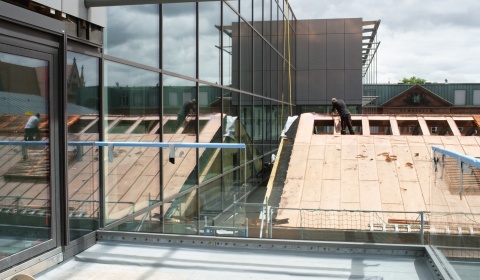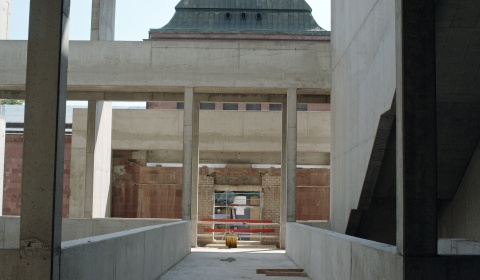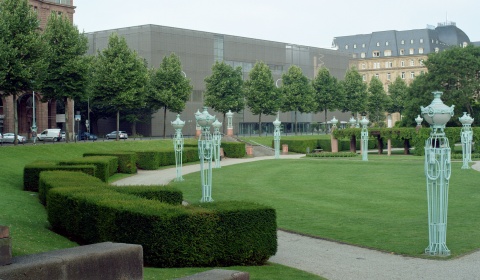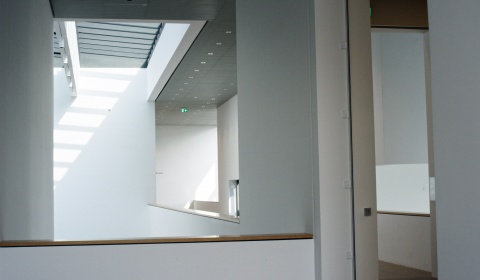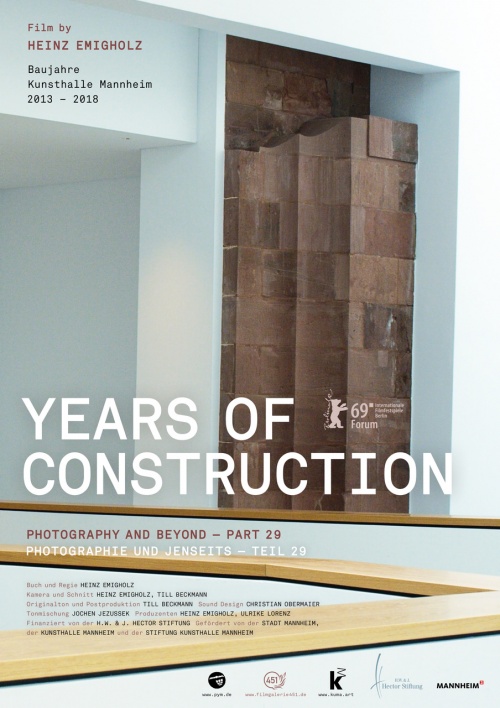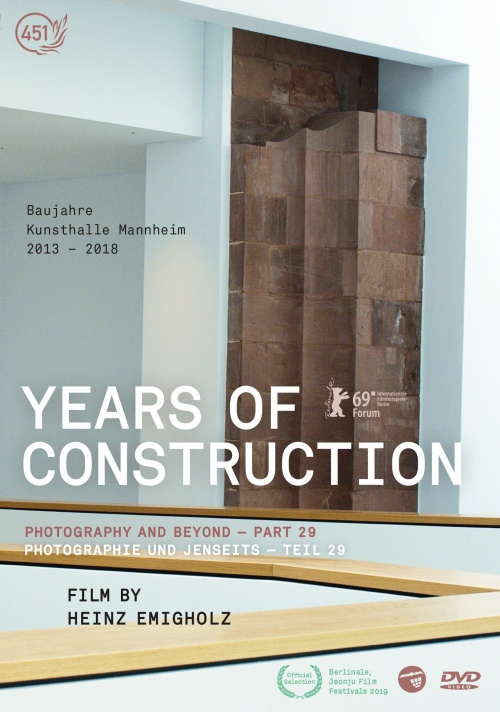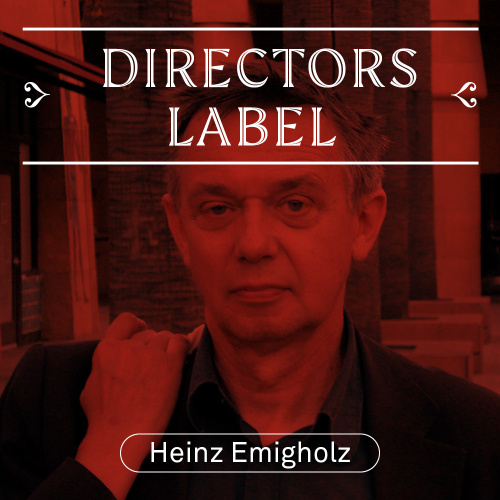
Years of Construction
GER 2019, 93 min
The renovation, demolition and reconstruction of different parts of the Kunsthalle Mannheim between 2013 and 2018. The before and the after are brought together in 93 minutes, allowing their comparison rather than letting them disappear in nebulous time windows.
Synopsis
Starting from the fountains in the Friedrichsplatz opposite, Emigholz’s camera approaches the building complex. A passage leads from the imposing Jugendstil edifice to the 1983 extension by Hans Mitzlaff. The sculptures it was built for seem to be trying to find their place in a space not big enough for them. The architecture isn’t suitable for paintings: it casts light and shadow according to its own whims. In between, Emigholz shows streets that cross at right angles, bridges and overpasses, the city of Mannheim. References to the vision of architects Gerkan, Marg and Partners: after the demolition and construction phase, a complex of cubes, passages and terraces appears and forms an interior. A stone and a clock swing through the air: “The Moving Emptiness of the Moment” is the name of the installation. Metal meshing holds the new Kunsthalle – a mighty cube when seen from the outside – firmly in its grip.
Shot over five years, YEARS OF CONSTRUCTION traces how one wing of the Kunsthalle Mannheim is torn down and re-built. Images rich in contrasts question the role of architecture and reflect on how the building ensemble relates to the rest of the city.
YEARS OF CONSTRUCTION is the 29. part of Heinz Emigholz’s series „Photography and beyond“.
Streaming-Info
Rent or buy the movie on our Vimeo channel.
Language: No dialogue
Film kaufen
VOD
451-Vimeo
DVD
451-Alive Shop
amazon
Awards and Festivals
- Berlinale Forum – Premiere am 11.2.2019
- Jeonju International Film Festival 2019
- Festival ECRÃ, Rio de Janeiro, Brasilien 2019
- Vancouver International Film Festival 2019
- Doclisboa - Festival Internacional de Cinema 2019
Additional Texts
Director’s Statement
(Heinz Emigholz)
We began shooting YEARS OF CONSTRUCTION on Saturday, 17 August 2013 and finished on Tuesday, 12 June 2018. When I decided to carry out this project, which had been suggested by Ulrike Lorenz, the director of the Kunsthalle Mannheim, I did not know who the architects would be. And I did not care, because what interested me, as the core of the project, was the process of construction, of renovation, of demolition, and of reconstruction, as well as the necessary repetitious loops of an accompanying contemplation.
All three activities – the preservation and restoration of the Billing building from 1907; the demolition of the Mitzlaff building from 1983, including the destruction of the Nazi-era underground bunker beneath it; and the new construction of the museum by gmp on a levelled foundation pit – are included in the film. You can see the before and after in chronological order, from the last exhibition in the old building to the first art installation in the new building. This also means that the before and the after are brought together in 93 minutes, allowing for their comparison rather than letting them disappear in nebulous time windows. There were also excursions in the urban surroundings, in whose traffic we let ourselves drift. The city of Mannheim offered a site of contemplation and meditation, which was built in all calm and excitement, while around it business continued as usual. That the idea arose of observing and documenting this construction activity was a worthy exception. Municipal archives and collections often only offer random discoveries, they seldom become active as producers of documentations. Television and public film funding bodies, because of their production processes and regulations, are usually unable and sometimes unwilling to take on this task. In this case, a commissioned artistic research project had to bridge the gap. I am grateful for this opportunity, because I think that documenting this world’s designed spaces and surfaces can reveal the mystery of the human spirit and of human activities.
Seeing is always also a liminal experience. In the five years we spent shooting YEARS OF CONSTRUCTION, there were thirteen phases of shooting, each two to three days long. In the same period, I completed five feature-length and three short films and several music videos; added to that was a severe illness that lasted a year and hindered my work. The Mannheim project therefore accompanied the principal, but also crisis-ridden, conclusion of my series of architecture films, and a renewed interest in advanced forms of cinematic narrative after a 25-year break. I think that this film also reflects this shift in a mediated way. It provides a space for thought and for necessary changes. ‘Changing of the guard’ has always been my motto. Long-term projects are fairly rare in cinematic biographies, unless an entire filmography is regarded as a long-term experiment, with many connecting lines and an uncertain outcome. I tend towards this perspective.
Producer’s Statement
(Ulrike Lorenz)
It was late autumn 2012 when I first met Heinz Emigholz in the Zwinger Galerie in Berlin. The wild sprawl and the iconographic texture of his series of drawings had hit me like a bolt of lightning. Never before had I encountered such a lucid dialectic between the pop-cultural worldliness of splinters and the overall hermetic withdrawal of meaning, drawn with the clearest lines. At the time, I was only able to perceive the architecture films by consciously looking past them, to use Paul Valéry’s expression. I was not capable of penetrating the wordlessly sound-rich image density; my gaze slipped off passing surfaces. It was only when the author’s voice suddenly rose above an anonymous Los Angeles intersection during the opening sequence of the film SCHINDLERS HÄUSER that something fell into place. Because the initial, focussing search was not rewarded with the discovery of a signature architecture, a mental suction effect ensued. From this point forward, my own thinking vision follows the vibrant, exploratory visual axes that, for more than 40 years, Emigholz and his camera have drilled through constructed reality like a tunnel.
In Mannheim, a new version of the more than 100-year-old modern art museum was to be developed. I was able to persuade the project’s private sponsors to also fund Heinz Emigholz’s anticipated film project. I address the artist directly. He answers with supreme indifference. My idea is to commission a hitherto unthinkable long-term project that will devour life energy and hours of work. Then Emigholz visits Mannheim. I set my mind on anchoring the Kunsthalle project in the urban context of this city, which was traumatically bombed in the Second World War, by situating it in the most beautiful square. With the magical Schindler moment in the back of my mind, I bring Heinz to the anonymous concrete growths that, since 2009, have made the strongest impression on me: the roaring traffic junction at the western edge of the city centre and the massive, smoking coal-fired power plant by the Rhine, which you can drift towards on a ferry as if it were a science-fiction fortress. Only later does it become clear that this not only contributes to the stream of Emigholz’s filmography, but also to our museum concept, ‘City in the City’.
Heinz agrees to do it. The initiated experiment, meticulously planned as a sequence of homogenous steps, develops an aesthetic sense of its own. For the first time, the film does not observe already existing spaces, but rather the gradual production of spaces through construction. Although the director continues to break down three-dimensional reality into cinematic compositions, constructing it anew in his projection, this second step in the design is overlain by the construction process itself, which generates unexpected narrative tension. In a way, this potentiates the energy fields within which the photography of the site takes place – a site that is completely transformed over a period of five years. In the film YEARS OF CONSTRUCTION, Emigholz photographically bolts together not only space, but also the fourth dimension of the filmed process. The constructed images of the reality under construction, arranged linearly, are layered upon one another through the act of seeing and remembering. The film thus forms an ‘imaginary architecture in time’ out of the years that it took to construct an emerging architecture in space, placing the viewer in the oscillating mode of an interactive film projection: ‘The eye as interface between brain and outside world, the gaze as a composing force that turns an idea outward, presents it reflected in reality and grasps it with the means of cinematography.’
Background Kunsthalle Mannheim
Kunsthalle Mannheim
As one of the first civic collections of modern art in the world, the Kunsthalle Mannheim numbers among the most renowned art museums in Germany, presenting key works from Edouard Manet to William Kentridge, as well as an outstanding array of sculptures – a focal point of the museum’s collection. Founded in 1909 as a museum for contemporary art, the institution led the way in shaping critics’ understanding and appreciation for modernism through its controversial acquisitions and innovative exhibitions. Already by 1910, it had purchased Edouard Manet’s monumental “Execution of Emperor Maximilian” (1868–69). Through numerous exhibitions such as “New Objectivity” (1925) and “Paths and Directions of Abstract Painting in Europe” (1927), in addition to museum premieres for Wilhelm Lehmbruck (1916), Max Beckmann (1928), the German and French Informels (1957–58) and Francis Bacon (1962), the Kunsthalle Mannheim directed academic discussion and shaped art history at that time. In 2018, it opened its new building – a dynamic new design which distinguishes itself fundamentally from conventional ideas of a museum. In accordance with its democratic founding principle of “art for all,” it has debuted an innovative digital strategy.
Architectural Ensemble
The Kunsthalle complex on Mannheim’s most beautiful square developed over the last century. It comprises Hermann Billings’ art nouveau building, built in 1907, and the new Hector Building, designed by the internationally operating architectural office gmp – von Gerkan, Marg and Partner, which was completed in 2017. As programmatic museum building concepts, both architecture styles could not be more different: one is light-flooded, timeless, open, and urbane, the other structurally expressive and imposing.
Art Nouveau Building
The Kunsthalle Mannheim’s historic original building was constructed in 1906–07, designed by Hermann Billing on the three-hundredth anniversary of the city for the International Exhibition of Art and Horticulture. The well-known Karlsruhe architect designed a gallery building with two wings, a central domed hall, and an imposing entrance flanked by a pair of lions carved from Mannheim’s characteristic red sandstone. Billing’s architecture, featuring glass ceilings and solid side walls to facilitate the hanging of paintings, complied with the most progressive museum standards of the time. The name “Kunsthalle” underpins the founding mission statement declared in 1909: The industrial city, the place where cars and bicycles were invented, would now dare to engage with contemporary art. To this end, the young Fritz Wichert developed the visionary concept of a “museum of meaning,” one that focused on the quality and singularity of its contents rather than adhering to a strict historical system. His Kunsthalle was not only notably committed to the artistic avant-garde and an aesthetic, humanistic education, but also contributed to Mannheim’s economic development as a city of culture.
New building on Friedrichsplatz
In December 2012, Hamburg-based gmp, Germany’s largest architectural firm, emerged as the winning entrants in an international competition to design the Kunsthalle Mannheim’s new building. The spectacular design concept for their first museum project in Europe plays on Mannheim’s historical chessboard street grid. Conceived as an open city within the city, the tailored architecture reclaims the dynamism and essential elements of urban space. Seven exhibition spaces frame a central square covered by a 22-meter-high glass roof. Thirteen galleries of varying dimensions – called cubes – are connected via bridges, staircases, and terraces, resulting in a 3,600 square-meter space devoted to modern and contemporary art. Enormous windows provide interior and exterior views from all sides and integrate the Kunsthalle into the city. Currently the most significant new art museum building in Germany, it was made possible with a no-strings donation of 50 million euros from SAP co-founder Hans-Werner Hector. The construction budget amounted to 68.3 million euros. The foundation stone was laid in March 2015. Just under three years later, the Hector Building was handed to the city of Mannheim as a gift on December 18, 2017.
Museum in Motion
On June 1, 2018 the Kunsthalle Mannheim celebrated the grand opening with the unveiling of its concept of a “Museum in Motion.” The idea behind the museum is directly tied to the democratic maxim that underscored the founding of the museum: a Kunsthalle for all, a place open to the world and a public space which invites people from all generations and cultures to bring their views and ideas and to be inspired to consider things in a new way. Instead of merely presenting the narrative of art history’s masterpieces to a single-file march of silent visitors, the Kunsthalle seeks to contribute to contemporary debates in our society. Existential themes are at the heart of the ever-changing collection displays, programmatic exhibitions, and diverse program of events. An exciting array of masterworks from classical, modern, and contemporary art lines the walls of the museum, while a unique array of locally grounded, temporary art projects is meant to encourage exchange and discussion among the museum visitors. Art becomes a catalyst for communication. An innovative digital strategy offers completely new tools and channels for understanding: The MuseumsApp, Collection Wall, Creative Lab, and Personal Museum Catalog intensify interactive discovery and participation. A new experience of museum-going and of art becomes part of everyday life.
Watch Movie
VOD
451-Vimeo
DVD
451-Alive Shop
amazon
Credits
Director and Screenplay
Heinz Emigholz
Director of Photography and Editor
Heinz Emigholz, Till Beckmann
Original Sound and Postproduction
Till Beckmann
Sound Design
Christian Obermaier
Sound Mixer
Jochen Jezussek
Producers
Heinz Emigholz, Ulrike Lorenz
Produced by
Heinz Emigholz Filmproduktion, Kunsthalle Mannheim
Financed by
H.W. & J. Hector Stiftung
Funded by
Stadt Mannheim, Kunsthalle Mannheim, Stiftung Kunsthalle Mannheim
DVD-Details
Extras
Deconstruction and reconstruction of the Kunsthalle Mannheim in 37 chapters (202 min), Chapter Navigation, Presskit, 32-pages booklet
Language
International Version (no dialogue)
Country Code
Code-free
System
PAL / Color
Length
93 min + 202 min Extras
Aspect Ratio
16:9
Sound Format
DD 2.0 + 5.1
Set Content
Softbox (Set Content: 2), 32-pages booklet
Release Date
29.03.2019
Rating
Info-Programm gemäß §14 JuSchG
Distribution Details
Screening Format
DCP (2K, 25 fps, 5.1)
Blu-ray Disc
Aspect Ratio
Digital, 1:1,78
Language
International Version (no dialogue)
Promotion Material
A1-Poster
License Area
Worldwide
Rating
Info-Programm gemäß §14 JuSchG


